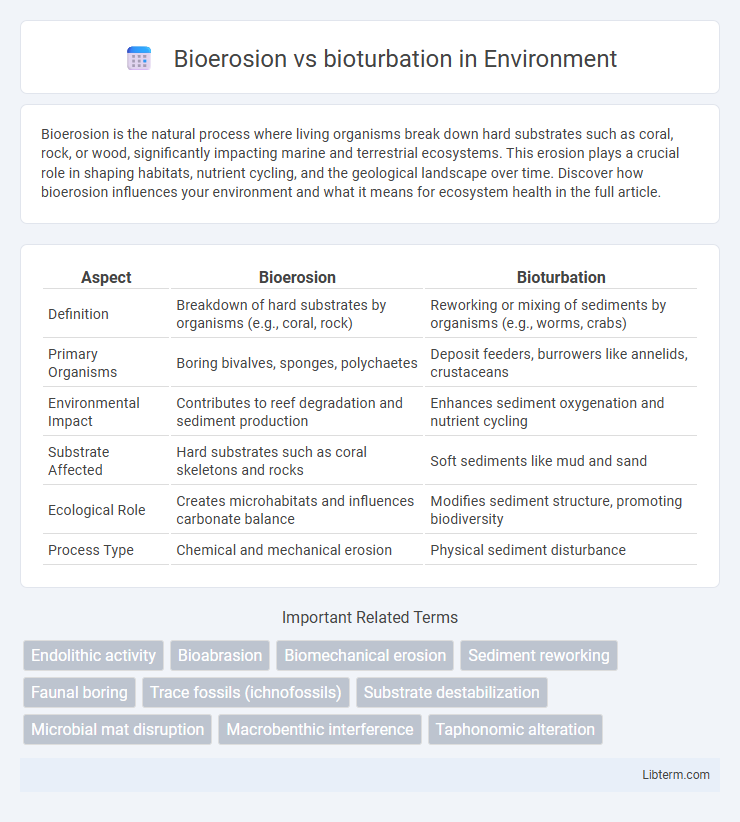Bioerosion is the natural process where living organisms break down hard substrates such as coral, rock, or wood, significantly impacting marine and terrestrial ecosystems. This erosion plays a crucial role in shaping habitats, nutrient cycling, and the geological landscape over time. Discover how bioerosion influences your environment and what it means for ecosystem health in the full article.
Table of Comparison
| Aspect | Bioerosion | Bioturbation |
|---|---|---|
| Definition | Breakdown of hard substrates by organisms (e.g., coral, rock) | Reworking or mixing of sediments by organisms (e.g., worms, crabs) |
| Primary Organisms | Boring bivalves, sponges, polychaetes | Deposit feeders, burrowers like annelids, crustaceans |
| Environmental Impact | Contributes to reef degradation and sediment production | Enhances sediment oxygenation and nutrient cycling |
| Substrate Affected | Hard substrates such as coral skeletons and rocks | Soft sediments like mud and sand |
| Ecological Role | Creates microhabitats and influences carbonate balance | Modifies sediment structure, promoting biodiversity |
| Process Type | Chemical and mechanical erosion | Physical sediment disturbance |
Introduction to Bioerosion and Bioturbation
Bioerosion refers to the biological breakdown of hard substrates such as rocks, coral skeletons, and shells by organisms like sponges, mollusks, and bacteria, playing a crucial role in shaping marine environments. Bioturbation involves the reworking of soils and sediments by animals or plants, enhancing nutrient cycling and sediment aeration through activities like burrowing, defecation, and sediment ingestion. Both processes significantly influence ecosystem dynamics, sediment structure, and habitat complexity in aquatic and terrestrial settings.
Definitions and Key Differences
Bioerosion refers to the process by which organisms, such as mollusks, sponges, and certain worms, chemically or physically erode hard substrates like rocks, coral, or shells. Bioturbation involves the reworking and mixing of sediments by living organisms, including burrowing animals, worms, and benthic invertebrates, altering sediment structure and nutrient dynamics. The key difference lies in bioerosion targeting solid, often calcareous materials through degradation, whereas bioturbation impacts loose sediments by displacement and reshaping, affecting sediment turnover and ecosystem processes.
Biological Agents Involved
Bioerosion primarily involves organisms such as sponges, mollusks, and certain types of algae that chemically or mechanically erode substrates like coral reefs and shells. Bioturbation is driven by benthic fauna including polychaetes, crustaceans, and burrowing worms that rework sediments through their burrowing and feeding activities. Both processes significantly influence sediment structure and ecosystem dynamics by altering physical and chemical properties of marine and terrestrial environments.
Mechanisms of Bioerosion
Bioerosion involves the breakdown and removal of hard substrates like coral, shells, and rocks through mechanical, chemical, or biological processes performed by organisms such as sponges, mollusks, and sea urchins. Organisms employ specialized mechanisms including chemical dissolution using acids or enzymes, mechanical rasping with radula or teeth, and boring through substrate via secreted acids or physical abrasion. This process significantly contributes to reef degradation, sediment production, and the alteration of marine habitats.
Processes of Bioturbation
Bioturbation refers to the reworking of soils and sediments by animals or plants, involving activities such as burrowing, ingestion, and defecation that alter sediment structure and nutrient distribution. This process enhances sediment aeration and organic matter decomposition, promoting diverse microbial communities and influencing biogeochemical cycles. Unlike bioerosion, which primarily erodes hard substrates, bioturbation reshapes soft sediments, impacting habitat complexity and sediment stability.
Ecological Impacts on Marine Environments
Bioerosion, involving the breakdown of hard substrates by organisms like sponges and mollusks, alters coral reef structures and reduces habitat complexity, affecting biodiversity and ecosystem resilience. Bioturbation, driven by burrowing organisms such as worms and crustaceans, modifies sediment composition and nutrient cycling, enhancing benthic productivity and influencing microbial communities. Both processes play critical roles in shaping marine ecosystems, with bioerosion often linked to habitat degradation and bioturbation promoting sediment mixing and ecosystem engineering.
Effects on Sediment Structure and Composition
Bioerosion alters sediment structure by breaking down hard substrates such as shells and coral skeletons into finer particles, increasing sediment heterogeneity and influencing carbonate sediment composition. Bioturbation reworks sediment layers through organismal activities like burrowing and feeding, enhancing sediment oxygenation and nutrient flux while disrupting stratification. Both processes critically impact sediment porosity, granulometry, and geochemical gradients, thereby regulating habitat complexity and biogeochemical cycles in marine and freshwater environments.
Contributions to Geological and Fossil Records
Bioerosion and bioturbation contribute significantly to geological and fossil records by altering sedimentary structures and affecting preservation conditions. Bioerosion, caused by organisms boring into hard substrates, creates trace fossils that provide insights into ancient ecological interactions and substrate composition. Bioturbation, involving the reworking of sediments by burrowing organisms, modifies sediment layers and influences soil formation, impacting fossil distribution and sedimentary dynamics.
Human Implications and Environmental Management
Bioerosion and bioturbation impact coastal ecosystems and marine biodiversity differently, influencing sediment stability and habitat structure essential for fisheries and coastal protection. Human activities exacerbate bioerosion through pollution and climate change, accelerating coral reef degradation, while bioturbation affects nutrient cycling critical for aquaculture productivity. Effective environmental management requires monitoring these processes to maintain ecosystem resilience, support sustainable resource use, and mitigate coastal erosion risks.
Comparing Bioerosion and Bioturbation: A Summary
Bioerosion involves the chemical or mechanical breakdown of hard substrates like coral and rock by organisms such as sponges, mollusks, and worms, significantly impacting reef structures and sediment production. In contrast, bioturbation refers to the reworking of soils and sediments by burrowing animals, including earthworms and crustaceans, which alters sediment properties and nutrient cycling. Both processes influence ecosystem dynamics, but bioerosion primarily modifies substrate integrity while bioturbation affects sediment mixing and soil aeration.
Bioerosion Infographic

 libterm.com
libterm.com